How to transplant aloe correctly?
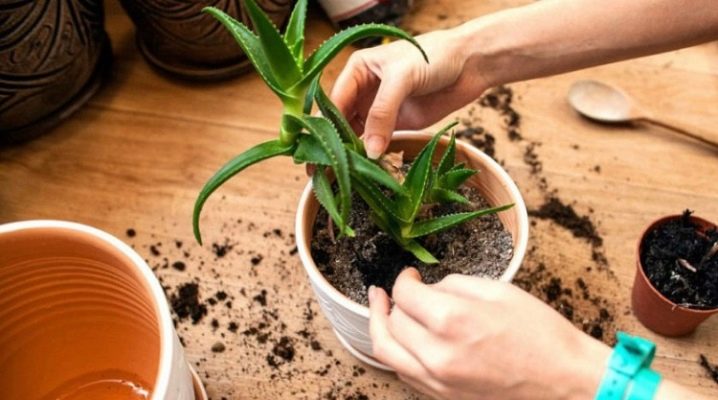
When growing indoor crops, the florist must follow the obligatory care measures for them. This also applies to indoor aloe. In order for the plant to retain its vitality, it may require a transplant, which is important to perform on time and subject to certain nuances.
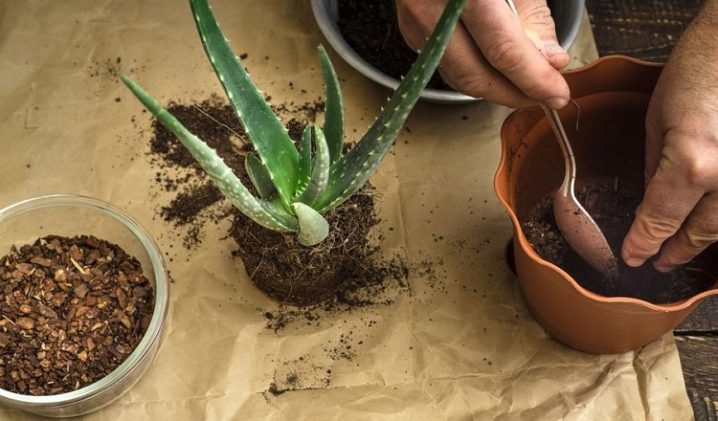
What is the transplant for?
Aloe is a succulent plant that needs space. Its powerful root system grows rather quickly, therefore, in the process of growing a beautiful and useful crop at home, the florist is advised to create comfortable conditions for its growth and development. Transplanting is a must to ensure that there is a healthy plant in the room.


There are a number of reasons why a perennial may need a transplant.
- The main reason why aloe is actively cultivated by humans is external attractiveness of culture. In order to preserve the beauty of the succulent, it will need to be transplanted from time to time, especially for an adult plant.
- In the process of growing culture young shoots will appear around her in a pot and on herself... With a large number of them, the florist is recommended to transplant the children into separate containers. The sprouts will take up a lot of nutrients from the mother crop, slowing down its development and depleting the soil in the pot. In addition, the plants will constrain each other and interfere with proper development, as a result, the flower can become one-sided or curved, which will negatively affect its appearance.
- In addition to an increase in the size of the aerial part, aloe also the root system grows, therefore, the container for the plant will need to be replaced with a larger one. Failure to follow this rule can cause some roots to grow through the drainage holes in the pot, making it difficult to later root in another pot. A clear sign that the aloe rhizome has become too large for the pot will be poor moisture penetration into the soil.
- It will be necessary to transplant the culture for a reason gradual depletion of the soil available in the pot. Succulents have a high coefficient of mineral removal from the soil, while nitrogen is consumed in it very slowly. This situation leads to the fact that the soil from a large amount of nitrogen simply turns into dust, and the top layer becomes stony, which blocks the flow of moisture to the roots. A flowering plant must grow in nutritious soil, otherwise, its lower row of leaves will die off, and the culture itself will become pale, as a result, the flower will wither.
- An urgent transplant will require aloe, if its root system starts to rot. Such situations can arise with excessive moisture of the culture, as well as due to the defeat of a perennial by any ailment. Signs of rotting will be sour soil in the pot and blackening of the crop. Such problems often arise in winter.
- You will need to transplant the plant into another container. after the purchase. This is necessary because the crops are sold in stores in a substrate that is not intended for indoor cultivation.
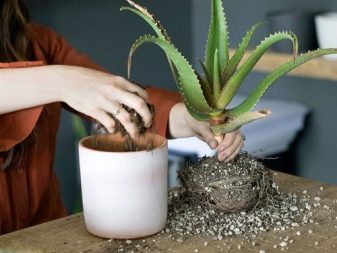
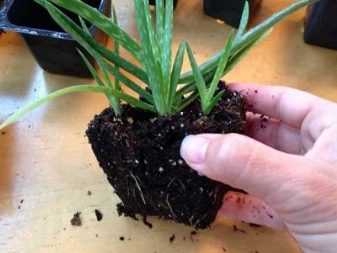
Experienced florists do not recommend performing a culture transplant without good reason, since these manipulations are a serious stress for the plant, after which it adapts to new conditions for a rather long time.
This also applies to replacing potting soil.

How often can you replant?
In a young culture that has not reached the age of three, the soil must be replaced annually with an increase in the volume of the pot used. This is due to the active growth of the flower. Upon reaching the age of three, the transplant is performed once every two years. It is recommended to root adult perennials in another pot no more than once every three years. Such crops will already develop at times slower, so they will not require an annual increase in the size of the pot.
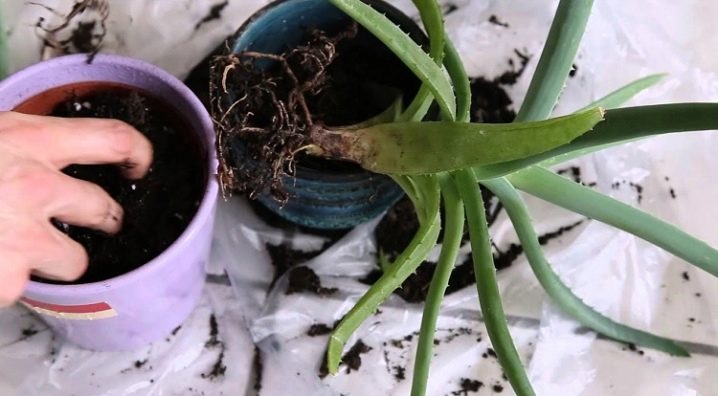
When is the best time to do it?
The best period for rooting aloe in a new container will be spring, it is important to choose the right time so that the plant only leaves the dormant phase and does not begin to actively develop yet. If you manage to transplant a succulent during this period, then the active metabolism accompanying the growing season will help the culture to quickly adapt to new conditions and maintain its health. This is especially true for the root system, which in any case will be disturbed and injured in the process of removing the plant from the old soil and rooting in a new container. Some growers perform aloe transplant in the summer, while propagating the culture.
It would be more correct to refrain from such work in the autumn and winter period, since at this time the succulent will already suffer from a lack of sunlight, which will weaken its immunity. In addition, the autumn-winter period is a dormant phase for aloe. As a result, the flower will take much longer to adapt to new conditions.
In the colder months, transplanting aloe can only be done in extreme cases.
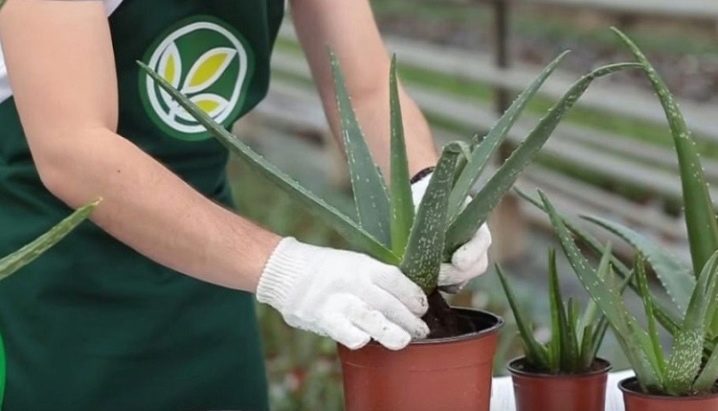
Preparation
Rooting a plant at home will require preliminary preparation of containers for planting. Its size should be selected depending on the age of the culture: for a young flower you need a large pot, for aloe with sprouts, you can only replace the soil, and also plant the "kids" in separate pots.
For cultivating succulents, it is recommended to use a plastic or ceramic container. In polymer pots, the plant will develop evenly, but in such a container it is necessary to ensure that moisture does not stagnate. As for ceramic pots, this material is able to pass air, which will contribute to the natural evaporation of excess moisture, as well as normalization of the temperature. Thus, it will be easier for the grower to take care of his plant in the future.
Before rooting the culture into the purchased container, it must wash well and dry well.
All pots should have drainage holes at the bottom for excess liquid to escape, if aloe is transplanted into an old pot, it must first be disinfected.
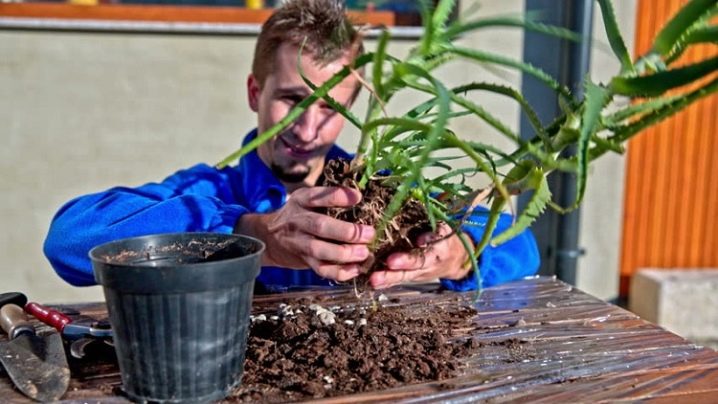
The correct preparation of the soil for the culture will help reduce stress for the plant; it is worth rooting aloe in a substrate that is as identical as possible in composition to the old soil. The soil can be purchased in the store or you can cook it yourself. In the first case, the substrate should be designed for growing succulents and cacti. If self-preparation of the soil is planned, then certain recommendations should be followed in this matter. The land should be:
- nutritious and light;
- with neutral acidity.
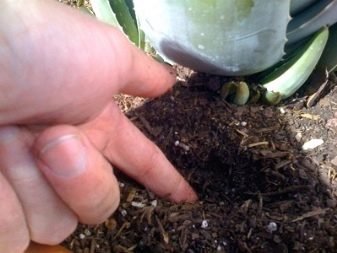
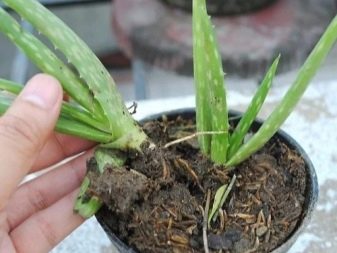
There are several options for preparing the substrate at home:
- the soil can consist of sand, leafy and clayey sod land, taken in equal proportions, with the addition of half of the peat;
- sheet soil, coarse sand and charcoal.
In addition to the pot and soil mixture, the culture itself must also be prepared for transplanting. In this case, a few days before the planned rooting of the plant in a new place, it must be well moistened. This will make it easier and with minimal damage to later remove the aloe from the old pot.
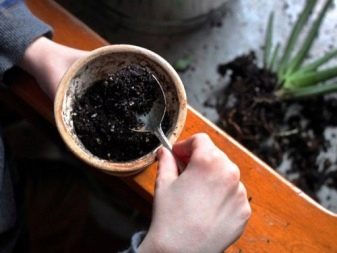
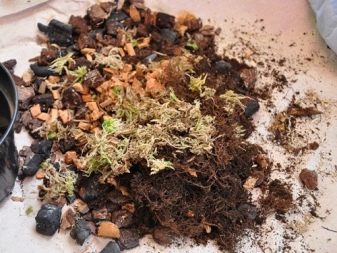
Step-by-step instruction
In order for an independent aloe transplant to be successful, it is recommended to adhere to the following work algorithm.
- Despite the fact that a succulent can be quite impressive in size, its stems are rather fragile, so you should take extra care when removing the culture from the old container. The flower grower must hold the plant with one hand, and with the other, tilt the pot in order to extract the aloe along with the rhizome and earthy clod. Before rooting a culture in a new container, the roots must be freed from the old soil.
- Together with the removal of soil, it is also recommended to examine the rhizome and, if there are damaged or dry roots, remove them. A layer of drainage should be laid on the bottom of the new pot, and sprinkled on top with sand and soil. Then the succulent is placed in the center, soil is added, but in such a way that the aloe rosettes are not sprinkled with soil mixture. At the end of the transplant, the soil in the pot should be tamped, and the leaves should be wiped with a damp cloth from dust.
It is recommended to water the culture only every other day.
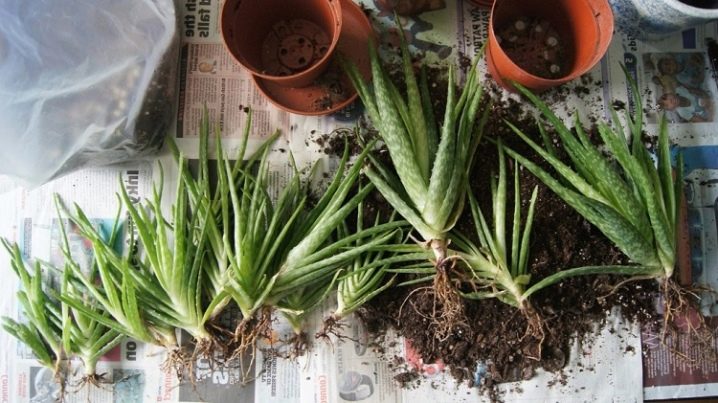
If a shoot without roots is transplanted, then the work is performed according to the following scheme.
- In an adult culture, it is necessary to separate the selected part, which is kept in the cold for 6 hours. Cold is necessary so that a crust forms faster at the cut site. In this form, the sprout will be suitable for rooting.
- It is necessary to plant aloe in a substrate similar in composition to that in which the mother culture grows. The pot can be selected small in size. Pebbles should be laid at the bottom, then covered with earth and the sprout should be rooted. The top layer can be slightly moistened. The culture will develop better if it is placed on the east or west side, excluding direct sunlight.
In open ground, aloe is rooted in summer, when the air temperature is at + 23 ° C. Planting is performed according to the following instructions.
- It is important to choose the right place for the plant. It should be lit, but without the scorching midday rays. Placing aloe in the garden, it is also necessary to provide the succulent with conditions so that the culture does not rot during the period of heavy rainfall.
- The rooting hole should be the size of the pot where the plant previously grew. At the bottom of the pit, you need to place sawdust and expanded clay. Then the aloe is located in the center of the hole and sprinkled with earth. It will be necessary to water the plant only when the soil is completely dry.

Follow-up care
After transplanting the succulent, it is recommended to properly position the crop pot indoors. Aloe grows well on lighted windowsills or verandas. It would be more correct to refuse additional artificial illumination with the help of phytolamps, since the culture will begin to stretch upward, which will negatively affect its visual appeal. Immediately after transplanting, the culture should be left in a shaded place, but after 2-3 days, transferred to a light windowsill.
It is not necessary to fill the plant, watering is carried out as the soil dries up in the pot. In winter, watering is sometimes reduced to once a month.
To moisten the succulent, you need to use settled water at room temperature.
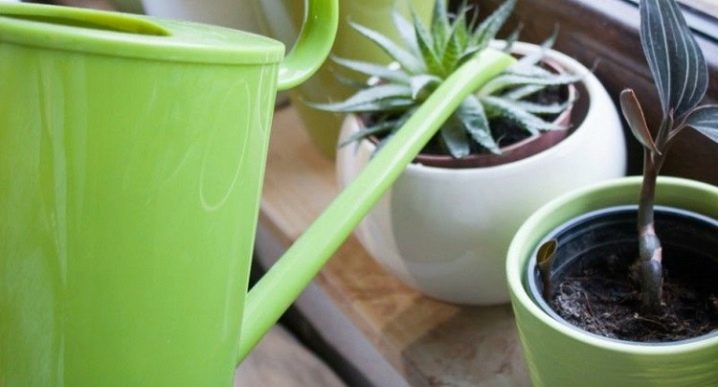
For crops rooted in the open field, additional fertilizing is not required, for indoor plants, flower growers are advised to regularly use complex fertilizers... As a rule, fertilizing is introduced every month in liquid form, the optimal time for using fertilizers will be the period from early spring to September.
Room temperature is most suitable for the growth of succulents. Aloe develops well at temperatures from +12 to + 30 ° C... This range is acceptable not only for adults, but also for young transplanted plants.
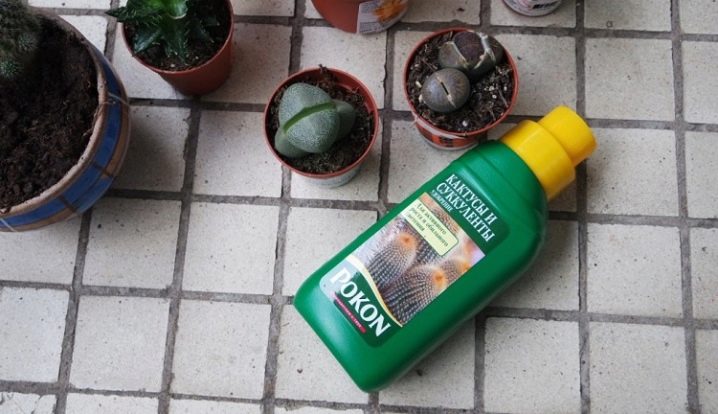
Possible problems
Succulent transplant is not particularly difficult, however, an inexperienced florist can make some mistakes.
- If an unsuitable soil mixture was used for rooting aloe, then the plant will soon begin to wither, and the leaves will become faded. Very often insect pests enter the pot with outdoor soil, in addition, the soil can be infected with fungal or bacterial infections. In this case, you should replace the soil in the pot with one intended for succulents.
- If you water the aloe abundantly immediately after transplanting, the culture may begin processes of rotting of the rhizome. In order to save the plant, you will need to remove the damaged roots and transplant the flower.
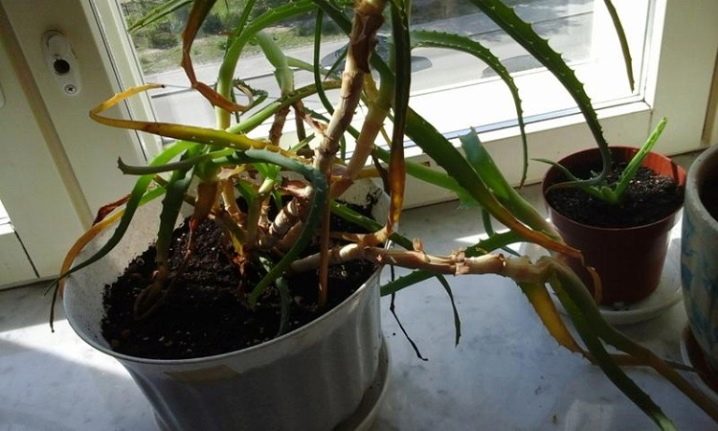
You can learn how to transplant aloe from the following video.























































Tell me, if the stem is too high, can it be shortened?
Pinching the top is not only possible, even necessary, to stimulate the growth of dormant buds on the stem. After that, the lateral shoots develop rapidly, and the crown of the aloe is noticeably rejuvenated. The cut off part, if it is large enough, can be rooted in a separate pot to create another plant. In some species of aloe, after trimming the top, the formation of root shoots is enhanced.
The comment was sent successfully.